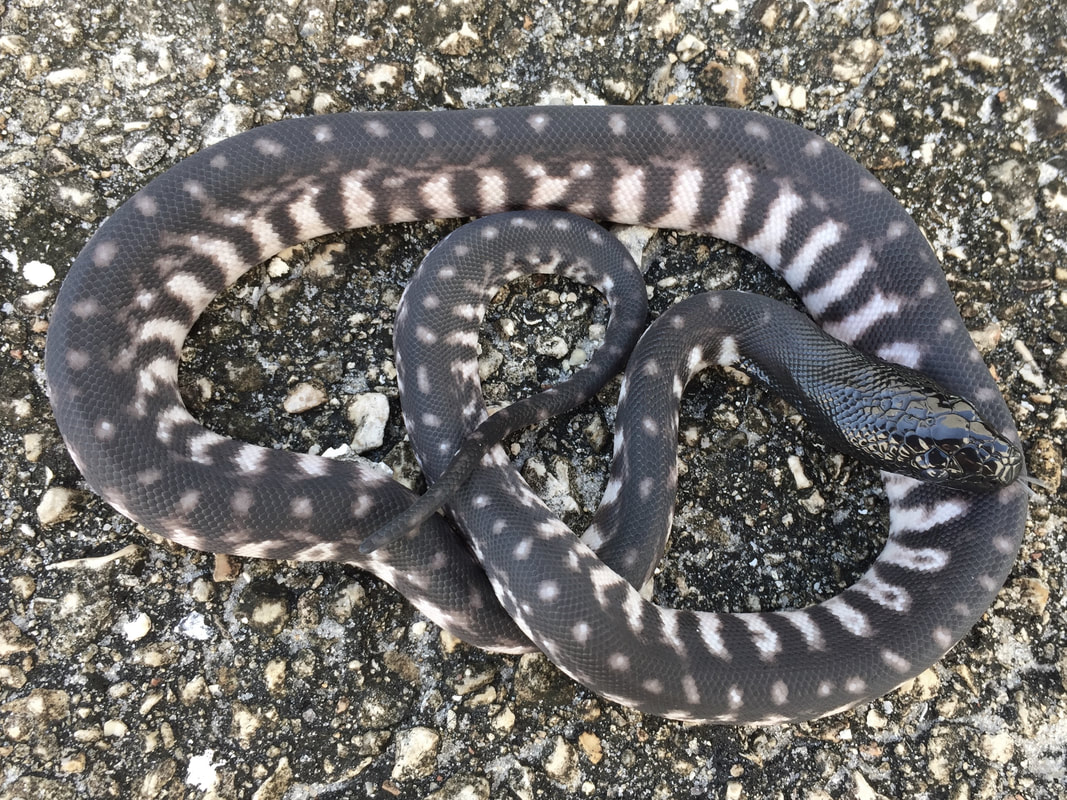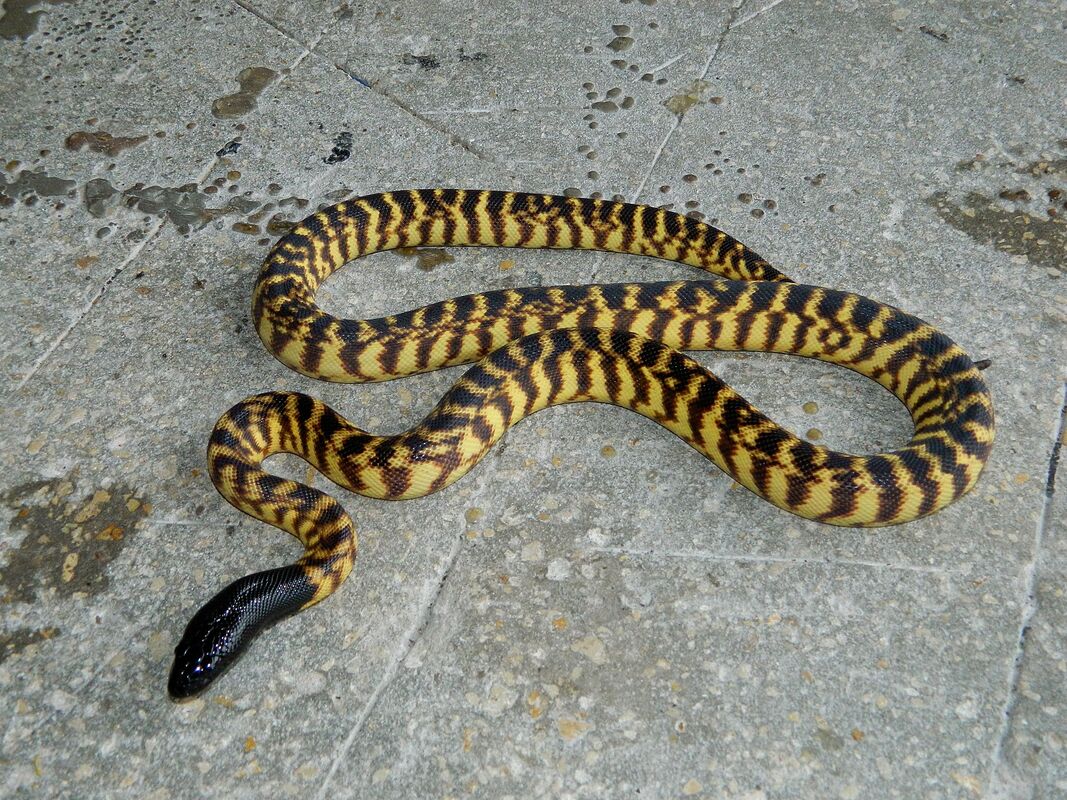CollectionHere are the lines and genetics I am currently working with and a brief explanation of each. Any other questions, feel free to email me on my contact page.
Western Lines
I have 2 separate western lines and also a combo of the 2 that I work with. Lazik Line The Lazik Line animals purportedly hail from 80 mile beach area (which is a fairly large area demographically but narrow and hugging the coastal region) Out of all the lines Ive worked with this line is by far the most consistent in "looks" with every animal almost being a carbon copy of the next. Hardly any variation among them other than natural variation of color which can range in ground color from almost white to a brownish tan but bands are very dark chocolate to black. My favorites of all my lines Ive kept. Goergen Line
Some of Goergen's western animals are purportedly from the Perth Zoo. After conversations with Dick and a few phone calls to the zoo itself we were able to establish their stock being from the Sandfire Desert region of western Australia. This was later confirmed through an email from the Perth Zoo. This area lies in between Port Hedland and Broome along the 80 Mile Beach Hwy. It is inland about 20Km from the coast. This line has more variation than the lazik line Ive noticed with bands varying from bold and black to thin and brown with varying degrees of ground color. Axanthic Morph
The first Axanthic animals showed up for me after 2 100% hatch clutches on 2009 from Zoo Line Northern Territory animals. (The previous being the clutches the Tigers came from). In 2009 I had 2 male axanthic hatchlings out of 8 eggs. Breeding trails to both the mother, sibs and non related animals proved this to be a simple recessive trait (although many keepers are now debating the mode of inheritance of axanthic animals along with several other traits across species lines as there does seem to be visible "hets" in some cases.) In 2010 I acquired an axanthic female (Line B) and a few male siblings from a fellow keeper who had hatched them spontaneously. I raised this female and bred her to my visible axanthic to produce normal offspring, indicating that the 2 forms are not compatible. These offspring will be carrying both Axanthic lines. In 2011 I hatched yet another Axanthic from Goergen lineage. This line has also be proven to be incompatible to the Line A Axanthic but this year (2018/19) did prove it out to be the compatible with line B. Very bright future with these genetics and possibilities. Tiger morph
The tiger morph started for me when I hatched 3 out of 10 in 2006/7 season. All males. 2009/10 season These males when bred back to their clutch mates and mother proved to produce more tigers in the predicted simple recessive ratios. The next breedings 2010-2014 were tiger to tiger which yielded all tigers and a ratio of solid black dead specimens. When a visible bred to non related normal, yielded a clutch of normals. When these animals were bred back to each other, predictably produced more tigers. During the next year 2015 I also produced more tigers out of animals that were thought to be unrelated. Thus far these breedings are yielding the same results but no dead animals are occurring in the visible to visible clutches. From Visible to Visible breedings I’ve had 3 clutches from the first line that have produced a percentage of Tigers and dead all black snakes and 2 clutches from the second line that have yielded all live Tigers. This year I proved out a second pair of “hets” from outcrosses to produced more tigers. I'm super stoked on working this mutation into other genes and projects. Tangerine Line.
I started my Tangerine Lines with several hypo type animals from several sources. The first being our original NT zoo line animals (that also made our line A axanthics and Tiger animals.) In that first clutch (2007) along with the tigers, there were 2 light orange males that were clearly stand outs from the rest of their clutch mates. They had no black on them except for their heads and their chins were reduced black. The better of those males was then bred to a gorgeous orange Goergen female in a friends collection. She was very old and faded out when I had finally gotten her in my collection but that didn’t stop her offspring from being the most vibrant orange/tangerine babies I had ever seen up to that point. Same for the brother bred to a nice red female from Mark Bell, Just outstanding results. From there, refining has turned this line into some of the most vibrant and clean orange/red animals available in the US. I used the name “tangerine” as the “hypo” term has too many variables for me to call it a single mutation. I could very well use my breeding results to show a simple recessive mutation but I do not believe that is what’s happening with most hypo species. The variation is too great within visible to visible clutches. Nobody ever second guesses albino, pied, etc nor should they “hypos” if it were an actual single gene mutation IMO. I believe the Hypo term in BHPs to be natural variation from line bred results. Take a look at K Brothers in Australia for example. They have had the most hypo animals ever produced and they’re the first ones to say line bred variation. With more and more refining I expect the Tangerine animals to be better and better with each generation. And they have been. The last generations example are outstanding. Yellow Jacket Line
Much the same as my Tangerine Line, the yellow Jackets started from a few abnormally yellow animals that hatched randomly. The first ones being from a Goergen/Lazik pairing I had done. They were much richer in yellow deep gold color that I'd never seen before in BHPs except for the Bumblebee in Australia at the time. In 2009 I picked up an outstanding yellow adult female that was produced by ISIS reptiles from Goergen/Lazik origins. Of course I had to breed these back to their parents (like all breeding I do here with different or “odd” animals) and also to the super nice girl from ISIS. In doing so, more yellow animals appeared and now most all animals hatched out of that line get super gold or bright yellow (like a jungle carpet) esp as they age. There have only been a couple that have stayed more of a butter color but still above average for most adult BHPs I am now on F4 and the results are better and better each year with most all clutch mates developing a deep rich yellow and Black Banding that is far beyond average BHP coloring. Especially as adults and thats where it matters IMO. |



















